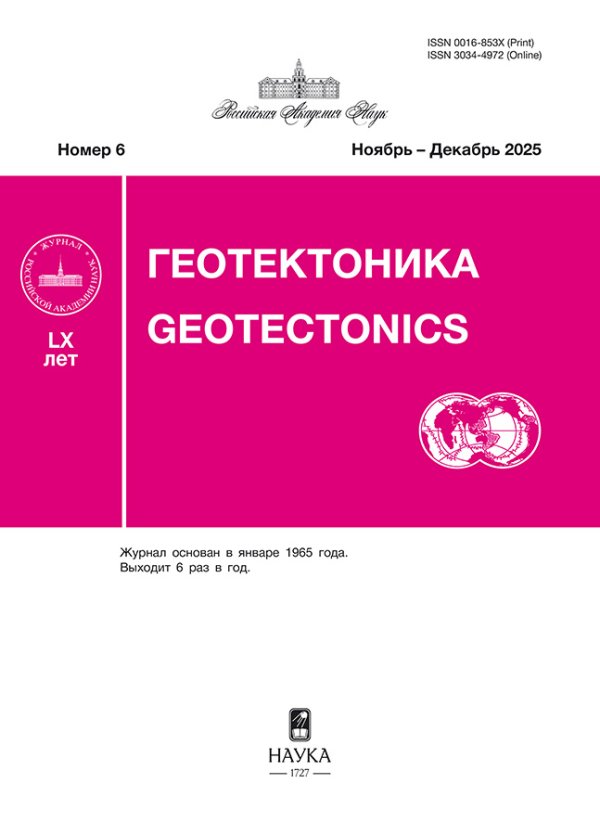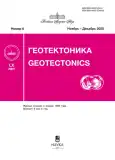№ 6 (2025)
Статьи
Положение в структуре суперконтинента Нуна палео- и мезопротерозойских комплексов Улутауского террейна (Центральный Казахстан): строение и обоснование возраста
Аннотация
В статье приведены результаты изучения и обоснование возраста (SHRIMP II, LA-ICP-MS) палео- и мезопротеозойских осадочных, вулканогенно-осадочных комплексов Улутауского террейна на западе Центрального Казахстана. Палеопротерозойские образования представлены кварцитами, сланцами кумолинской свиты с максимальным возрастом седиментации 2.03 млрд лет, которые вместе с терригенными толщами Чуйско-Кендыктасского и Иссыкульского террейнов маркируют древнейший этап накопления зрелых осадочных последовательностей в западной части Центрально-Азиатского пояса, связанный с раскрытием рифтогенных бассейнов в пределах суперконтинента Нуна на стадии постколлизионного растяжения. К мезопротерозойским образованиям относится бимодальная вулканогенно-осадочная ассоциация жиидинской серии (~1326–1367 млн лет), связанная с эктазийским этапом рифтогенного магматизма, сопровождавшим распад суперконтинента Нуна. Полученные данные предполагают, что в палео- и мезопротерозе Улутауский террейн, Таримский кратон и кратон Янцзы имели близкую эволюцию, связанную с внутриплитными тектоно-магматическими процессами, проявленными в западной и северо-западной частях суперконтинента Нуна.
 3-30
3-30


Структурная эволюция и этапы деформаций средне-позднепалеозойских коллизионных комплексов палеоокеанического сектора Южного Урала
Аннотация
Проведены детальные структурные исследования структурно-формационных зон палеоокеанического сектора Южного Урала. Установлена последовательность формирования мезоструктурных парагенезов, что позволило реконструировать структурную эволюцию региона и разработать новую модель, основанную на особенностях метаморфизма Восточно-Уральской мегазоны, в которой мегазона является частью Магнитогорской островодужной системы, при этом Магнитогорская островная дуга, частично, энсиалическая, и, частично, ‒ энсиматическая. В структурной эволюции палеоокеанического сектора Южного Урала в ходе средне-позднепалеозойских коллизионных событий установлены D1 и D2 этапы деформаций. Первый этап деформации D1 выразился в формировании изоклинальных складок западной вергентности на западе Магнитогорской мегазоны и складок восточной вергентности на ее востоке. В Восточно-Уральской мегазоне на этапе D1 образовались складки юго-восточной и запад‒юго-западной вергентности. Этап D1 маркировал процесс косой левосторонней коллизии Магнитогорской островной дуги с окраиной палеоконтинента Балтика в конце девонского периода. В результате деформаций, происходивших в условиях левосторонней транспрессии, на этапе D1 на Южном Урале сформировалась бивергентная структура типа “пальмового дерева” с образованием складок F1 западной вергентности (в Актау-Таналыкской зоне) и складок восточной вергентности (на востоке Западно-Магнитогорской и Восточно-Магнитогорской зон), а также складок юго-восточной и запад‒юго-западной вергентности (в пределах Восточно-Уральской мегазоны). Второй этап деформации D2 был связан с позднепалеозойской Уральской межконтинентальной коллизией в конце среднего карбона–перми. Этап D2 был отмечен завершением формирования зоны Главного Уральского разлома, образованием складок F2 северо-западной вергентности в Актау-Таналыкской зоне. К этапу D2 относится формирование складок западной и северо-западной вергентности в Восточно-Мугоджарской мегазоне и всех структур Зауральской мегазоны. Образование поздних, преимущественно левосторонних сдвиговых складок с крутопадающими шарнирами, соответствовало этапу постколлизионных сдвиговых движений, завершивших структурную и геодинамическую Эволюцию Уральского палеоокеана.
 31-62
31-62


Структура протерозойского комплекса Камско-Бельского прогиба (северо-восток Русской плиты): особенности формирования, фильтрационно-емкостные свойства пород, параметры моделирования миграционно-аккумуляционных процессов
Аннотация
В статье рассмотрены структурные и тектонические особенности строения рифейско‒вендского разреза Камско-Бельского прогиба. Показано, что его формирование определяется слоисто-блоковой (до глубины 3500 м) и блоковой (на глубине более 3500 м) геофильтрационной структурой протерозойского разреза. На основании анализа литологического состава отложений Камско-Бельского прогиба выявлены (i) регионально развитые латеральные проводящие толщи, (ii) низкопроницаемые толщи с подчиненным развитием коллекторов и (iii) субвертикальные проницаемые зоны. При этом хорошо выраженные потенциально латеральные проводящие толщи выделяются в рифейских (ротковская, тукаевская, леонидовская свиты) и вендских (байкибашевская (кыквинская) свита) отложениях. На основании результатов лабораторных исследований 1600 образцов керна выполнена диапазонная оценка фильтрационно-емкостных свойств наиболее типичных литотипов протерозойских пород Проведена комплексная оценка фильтрационно-емкостных свойств пород, включающая (i) эмпирические зависимости, (ii) долевой литологический состав объектов, (iii) анализ литотипов с учетом слоисто-упорядоченного и слоисто-неупорядоченного строения. Для проведения моделирования миграционно-аккумуляционных процессов в факторно-диапазонной постановке введены экспертные параметры проницаемости для различных литотипов пород. Оценка средневзвешенной проницаемости и сопоставление результатов расчета проведены на основе разрезов отдельных скважин с последующим обобщением для территориальных зон Камско-Бельского прогиба. В качестве примера представлен расчет диапазона проницаемости геофильтрационных элементов для модели слоисто-упорядоченного и слоисто-неупорядоченного литологического строения толщи по данным скважины Арланская-7000.
 63-84
63-84


Тектонофизическое районирование активных разломов Алтая и Западных Саян, выделение участков подготовки сильных землетрясений
Аннотация
Выполнено тектонофизическое районирование активных разломов по уровню кулоновых напряжений для Алтая и Западных Саян. Источником данных о напряжениях являются механизмы очагов землетрясений и модифицированный алгоритм метода катакластического анализа разрывных смещений, реализованный в новой компьютерной программе STRESSseism v.3.0. По результатам реконструкции напряжений уточнены кинематические типы региональных разломов и углы их погружения в верхней части коры (5‒15 км). Выделено пять зон с системами разломов, имеющими критически высокий уровень положительных значений кулоновых напряжений при протяженности опасных участков разломов более 50‒70 км. Предлагается полученный результат рассматривать как детерминированный долгосрочный прогноз зон подготовки сильных землетрясений с магнитудами Mw ≥ 6.5‒7.0 и, возможно, c более высокими магнитудами.
 85-118
85-118












